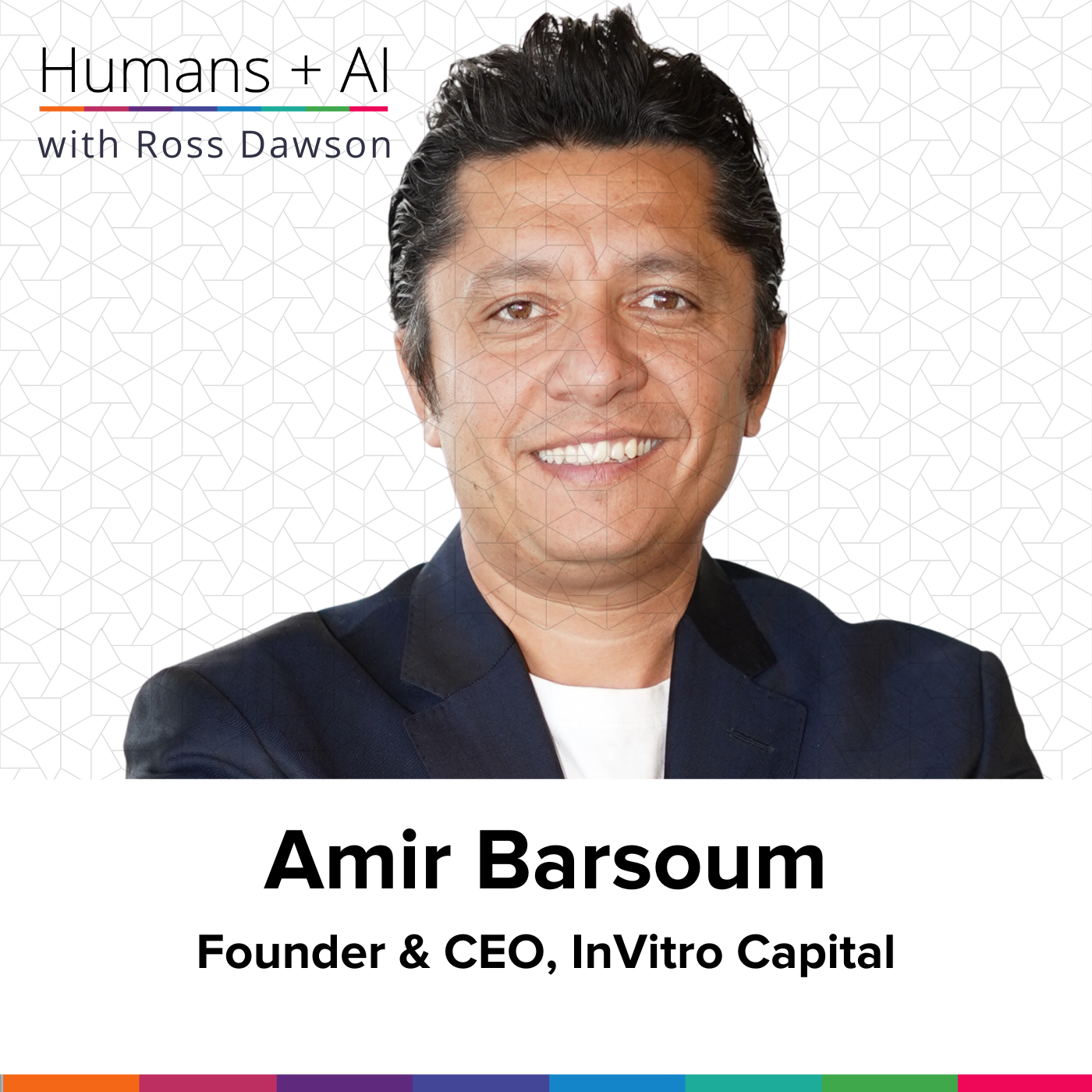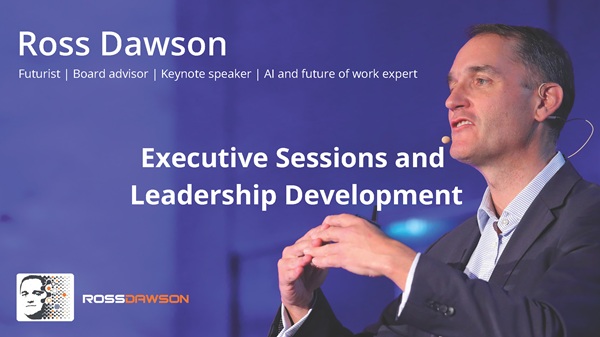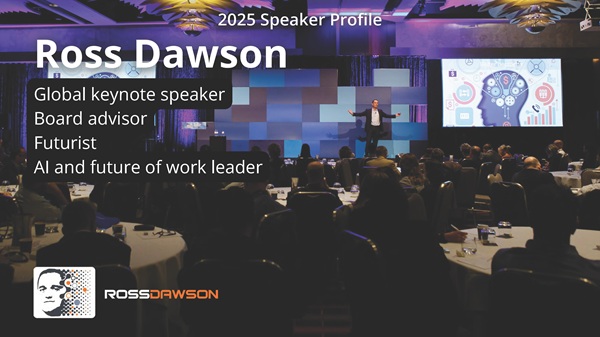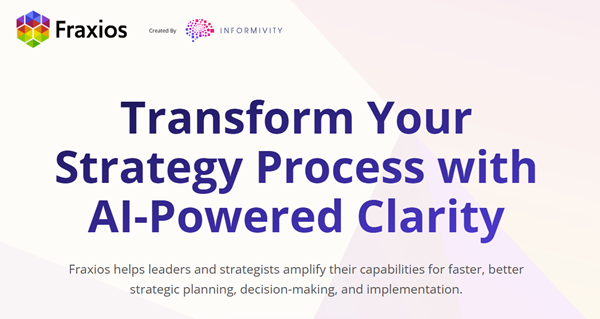“Successful AI ventures are those that truly understand the technology but also place real human impact at the center — it’s about creating solutions that improve lives and drive meaningful change.”
– Amir Barsoum

About Amir Barsoum
Amir Barsoum is Founder & CEO of InVitro Capital, a venture studio that builds and funds companies at the intersection of AI and human-intensive industries, with four companies and over 150 professionals. He was previously founder of leading digital health platform Vezeeta and held senior roles at McKinsey and AstraZeneca.
What you will learn
- Understanding the future of AI investment
- Exploring the human impact of technology
- Insights from a leading AI venture capitalist
- Balancing risk and opportunity in startups
- The evolving relationship between humans and machines
- Strategies for successful AI entrepreneurship
- Unlocking innovation through visionary thinking
Episode Resources
Transcript
Ross Dawson: I’m here. It’s wonderful to have you on the show.
Amir Barsoum: Same here, Ross. Thank you for the invite.
Ross: So you are an investor in fast-moving and growing companies. And AI has come along and changed the landscape. So, from a very big picture, what do you see? And how is this changing the opportunity landscape?
Amir: So, actually, we’re InVitro Capital. We actually started because we have seen the opportunity of AI.
We actually started with the sort of the move. And a big part of the reason of what we started is we think that the service industry—think about healthcare and home repair, even some service providers today—they’re going to be hugely disrupted by AI. Whether there will be automation, replacement as a bucket, or augmentation as a bucket, or at least facilitation.
And we’ve seen a huge opportunity that we can build. We can build AI technology that could do the service. Instead of being a software-as-a-service provider, we basically build the service provider itself.
So that’s what excites us about what we’re trying to do and what we’re building.
Ross: So what’s the origin of the word InVitro Capital? Does this mean test tubes?
Amir: So, I think it originates from there. I think the idea is we’re building companies under controlled conditions. And it’s kind of the in vitro—in vitro fertilization, like the IVF.
We keep on building more companies under these controlled conditions. That’s the idea, and because we come from a healthcare background, so it kind of resonated.
Ross: All right, that makes sense. So, there’s a lot of talk going around—SaaS is dead. So this kind of idea, you talk about services and the way services are changing.
And so that’s—yeah, absolutely—service delivery, whether that’s service by humans, whether it’s service by computers, whatever the nature of that, is changing. So does this mean that we are fundamentally restructuring the nature of what a service is and how it is delivered?
Amir: I think, yes. I think between the service industry and the software industry, both of them are seeing a categorical change in how they’re going to be provided to the users. And, I mean, the change is massive. I’m not sure about the word “dead,” but we’re definitely seeing a huge, huge change.
Think about it from a service perspective, from a software perspective. In software, I used to sell software to a company. The company needs people to be smart enough, educated enough, trained enough to use the software and give you value out of it. They used to be called the system of records with some tasks, but really it’s a system of record that has a lot of records, and then somebody—some employee—who sits there and does the job.
In the service, it’s kind of, you think this is going to be very difficult, and they’re going to do somebody as an outsource to do the service for me. Think about, I’m going to go and hire someone who’s going to help us do marketing content, or someone who would do even legal—and I’m going to the extreme.
And I think both are seeing categorical change. The software and the employee, both together, could become one, or at least 80% of the job could be done now by AI technologies. And the service—the same thing. So we’re definitely seeing a massive change in these aspects. And talk legal, talk content marketing—all of them.
Ross: I’d like to dig into that a little bit more. But actually, just one question is around pricing.
Are you looking at or exploring ways in which fee structures or pricing of services change? I mean, that’s classically where services involved humans—there was some kind of correlation to the cost of the human plus the margin.
Now there is AI, which has taken often an increasing proportion of the way the service is delivered. So—and different perceptions where clients, customers think, “Oh, you must be able to do it really cheap now, so give it to me cheaper.” Or maybe there’s more value created.
So are you thinking about how fees and pricing models change for service?
Amir: I have a strong concept when it comes to pricing and innovation.
Think about ride-hailing when it has been introduced in the market. It was introduced at the price-competitive advantage compared to the yellow cab, right? Yes, you can come in with many other better benefits, like it’s coming with security and safety, but the reality is, it’s there. That’s when you hit the mass market—you need to play on pricing. And I think that’s the beauty of innovation.
And I think AI as a technology, and with its very, very wide use cases, it’s going to make every single thing around us significantly cheaper. Let’s take the same ride-hailing example. If you introduce the auto-driving ride-hailing, we are literally taking almost 70% of the cost today off of the table.
So if you’re not going to introduce a significantly cheaper price, I don’t think it’s going to find the mass market. So that’s from a form of the absolute value of pricing—how to think of pricing.
So where I would split this into two categories—we tried going and we basically say, “You know what, if you hire a person, it will cost you X. Hire an AI person, and it will cost you Y.” I find this not working very well.
Where where seeing the pay-as-you-go model is the easier way, the more comprehensible way. So, you think about the SaaS pricing, if you think about the service pricing—and that’s a continuum—I think we’re somewhere in the middle.
And I think the best is closer a bit to the SaaS pricing, but more about—you use more, you pay more—kind of a game, rather than feature-based pricing. So consumption-based pricing, but less related to the FTE.
Because, for example, when you say, “We have a recruiter, AI recruiter,” and you say it’s $800 a month instead of paying for a full-time recruiter, human recruiter, who is $7,000 a month—then what is the capacity of this AI recruiter? Is it equal to the human recruiter? Or it’s an unlimited capacity?
So we find this is not working really, really well. What works is really use-based, not feature-based events.
Ross: Right. So moving away from necessarily time-based subscription to some kind of consumption—
Amir: Consumption-based, yeah. Yeah, you could time it. You can time it a little bit as to timing, but really, it’s a consumption-based.
Ross: Yeah, and there is also the new models like outcome-based, such as Sierra, where they price—if you get an outcome, where you get a customer resolution, you pay. If you don’t, then you don’t.
Amir: Which is—this one is actually—so we have a company that we’re going to put in the market that is related. That is related to AI GTM—so AI go-to-market solution.
We’re going to go with the model of, “You know what? Pay when you get.” Which I think is a very, very interesting model. It’s a super good and easy way to acquire customers.
But you also need them to be a little bit engaged in some input so you can do a great job for them. But if they haven’t paid, then you’re going to find it—the engagement component—I think the funnel drops a little bit there.
We haven’t fixed that yet, but I think somehow it mixes between the consumption-based, but very, very small, and then more of the pay-per-outcome. I think this would be the fascinating solution.
Ross: Yeah, yeah. Well, it’s certainly evolving fast, and we’ll experiment, see what works, and work on that.
Amir: So I’ll tell you about it. I’ll tell you what’s going to happen.
Ross: So you have your healthcare background, you’re InVitro Capital, you are investing in the healthcare sector.
So I’d like to sort of just pull back to the big picture. So there’s a human-plus-AI perspective. And thinking more—there are humans involved, there’s AI, which is now complementing us.
Of course, there’s been many things in healthcare where AI can do things better and more effectively than people—just doing things which are not inspiring. And there’s also a lot of abilities to complement AI in how we deliver services, the quality of those services, and so on.
So best you can, just sort of take a big picture and say, what are that—where in this flow of healthcare do you see opportunities for humans and AI to do things better, faster, more effectively than they’ve done before?
Amir: So, healthcare—because the technicalities of the technical component of healthcare—is a very sensitive topic. When you start getting into the clinical decisions of it, it’s a very sensitive topic.
But in reality, healthcare is written in books, right? Especially the non-intervention healthcare. You think about the primary care—most of the non-intervention is written in books. And the LLM models know them. And even with many other data models you have—and even the big healthcare systems—they have tons of this data.
So you can actually today go straight away with some of the clinical solutions. You know, if you take a picture now as a consumer of something on your skin and put it on, it can kind of give you a very, very good answer.
But is this something that we think is ready to be commercialized and go to market? The answer is: no, not today.
But we’re seeing, on the other side, every single thing until the clinical decisions is seeing massive, massive augmentation.
And we think about it from a patient journey perspective. And in the patient journey, there are anchors as well. You can see it with the provider side, but see the accessibility component—where can patients access healthcare?
And I mean having the conversation and the scheduling and the difficulty of the scheduling and getting third parties involved. And this is not a typical administrative task—there are some medical people who used to be involved in this.
So, for example, the patient can’t see the diagnostic center unless you get an approval. But when you try to get an approval from the insurance firm, the insurance firm declines. So you need to get one more comment here, one more writing here, to get the insurance firm to approve.
Can you do these kinds of things—which is not the billing part, it’s still accessibility? And we are—we’re seeing AI technology playing a significant role in this.
Take it to the next step: billing, for example, which is really getting the provider to be paid for this visit, and maybe start diverting what is the copay and what is not. A lot of people are involved in this, and we’re seeing massive, massive implementation in that space, and workflow automation in that space as well.
Ross: So just coming back to that. So this idea of workflow, I think, is really critical. Where you mentioned this idea of approvals.
And so, yes, part of it is just flow—okay, this thing is done, it then goes on to the next person, machine, whatever system or organization. But this comes back to these decisions where essentially AI can provide recommendations, AI can basically be automated with some kind of oversight. There may be humans involved with providing input.
So in healthcare—particularly pointed—I mean, I suppose even in that patient experience process. So how are you thinking about the ways in which AI is playing a role at decision points, in terms of how we shift from what might have been humans making decisions to now what are either AI-delegated or AI-with-humans-in-the-loop or any other configuration?
So how are we configuring and setting up the governance and the structures so these can be both efficient and effective?
Amir: In very simple terms, there are the workflows and there are the AI workflows, which are very different—very different from how technology is designed and built, and very, very different in their outcome.
I think every single thing that we tried to do before in healthcare using workflows was, at best, not working. It even could look nice, but it just didn’t work. That’s the fact.
Because you start building algorithms and start putting rules in your code—if this happens, do that; if this happens, do that—you never cover enough rules that would make it really solid. And if you do, then the system collapses.
I think now we are at the stage where there are data models that you keep on indicating—this data model on whether this worked or not, the satisfaction level of the patient, whether this ended up in crazy billing and payment or not, whether this ended up in actually losing money for the provider or not losing money for the provider, the amount of time that has been lost, whether we have utilized the provider’s time or not—which is the most expensive component until today.
We talk AI, but still, we need healthcare providers.
So there, you build these data models that make the AI take decisions on: shall I book Amir tomorrow at 2 p.m., or I’d rather book Amir the day after tomorrow?
There are many, many data points that need to be considered in this intervention—Amir’s timeline, the doctor’s timeline, availability. These are the easy parts.
But the not-easy part is what the data models tell us—that makes the AI think like a human and on its feet, and saying, “You know what, I would book Ross tomorrow, but Amir the day after tomorrow,” because of the tons and tons of things: utilization, expectation, what’s the time that you’re going to take—leveraging on history of data that could work.
And the more you move into the billing component—and by the way, I know most of the people in healthcare think more about the clinical decisions—but in reality, healthcare is decided by payment and billing. These are the two biggest points, right?
Ross: So one of the interesting things here—I guess, pointing to the fact—we’ve got far more data than ever before, and hopefully we’re able to do things like measure emotional responses and so on, which is important if we’re going to build experience.
I mean, just massive things that can feed into models. But one of the points is that healthcare is multiparty. There’s a whole wealth of different players involved.
And there are some analogies to supply chain, except supply chains are far easier than healthcare. You have multiple players, and you have data from many different participants. And there is value to optimizing across the entire system, but you’ve got segregated data and then segregated optimization algorithms.
And in fact, if you optimize within different segments of the entire piece, then the entire thing as a whole may, in fact, end up being worse off than it was before.
So do you have a vision for how we can get to, I suppose, healthcare-wide optimization based on data and effective AI?
Amir: That’s a very, very, very good question, honestly—and quite deep.
So, healthcare has been—there are the payers, the insurance—the guys that pay the money. There’s the healthcare providers. And those—think about it—healthcare providers as entities, the organization. And healthcare providers as individuals—the doctors, the nurses, the pharmacists, right?
And then there’s the patient. And there’s the employer.
So there are all of these components together.
And we have been seeing a trial of creating vertical integration in healthcare in the past—a payer buying hospitals, buying clinics—and thinking that this is going to be cheaper for him, and it is. And to do it—but it has been slow because it’s very difficult to run a complete insurance firm and a healthcare provider—hiring doctors and managing workflows and payroll and the quality of patients, and making sure that the patient liked your hospital so they can come again, or your clinic, and not leaving or walking away.
And then what we are seeing is—there’s a very well-known concept in AI, which is the flattening of the org structure.
I think we’re going to see this in healthcare.
It becomes easier to do this vertical integration—the clinic, the scan centers, the pharmacists, the hospitals. It’s becoming way easier with time, by basically automating and using AI and augmenting what we do today—and shrinking, kind of running it together.
I think we’re going to see this more and more in the future.
Ross: The existing players start to do roll-ups or consolidate. So that becomes quite capital intensive in terms of being able to build this vertical integration. So either you build it out, or you buy it.
Amir: Or you build it out without being super capital intensive, because you’re using tech that is, again, you don’t need to be as capital intensive as you used to be before.
You know, for example, the working capital of people involved is going to be significantly less than what you used to see before. I’m less talking about the hospitals at this stage, but I think the outpatient setup will definitely see this.
I’ll give you an example. In the pharmacy business, we have automated—not fully automated, but augmented. In the pharmacy business, think about it. It’s a small factory. You get the prescription, somebody needs to type the prescription—we call them typists. Then somebody needs to fill it, and then a pharmacist needs to check it.
So we’ve automated many, many of those, using even some machines there until the filling component. Then the pharmacist would show up and do the checking.
So the working capital is shrinking, the time is becoming way and way more leaner, and hence it’s way more efficient.
Ross: So let’s pull back to the big picture of how does AI impact work, society, investments—everything. So what are any macro thoughts you have around how some of the big shifts—and how we can basically make these as positive as possible?
Amir: So I will give you my answer from what I’m seeing in the AI and the service intersection, because we are doing a lot of work in that space.
I think many, many of the jobs gonna vanish and cease to exist. But also, very interesting, we’re seeing a massive uptake in the EdTech, where people are jumping in to kind of elevate their skill sets.
And I think the time is there. It’s not a crazy, gloomy picture. I think there’s some time they can actually get that and fill up the space.
The level of shortage we’re seeing in healthcare is unheard of, and we are aging as a population. And the reality of the matter—we need those. So I need less people working on the reception and the billing department, and I want more people who could provide some level of healthcare component.
And we’re seeing this happening. Think about the home repair. I need less people who do administrative work, and I need more electricians, and I need more plumbers.
And I think we’re seeing more jumping into the EdTech components, getting these preparation to the exams and the test to kind of elevate themselves into this role.
And I think AI is definitely accelerating the elimination of the jobs, but also accelerating access to education so that you can capture the new job. And we’re definitely seeing these two pieces happening, I would say, in a very, very fast pace.
So that’s one thing we’re seeing.
From an investment perspective, we look at investment into three categories. We look at them into:
Category A: Investing into foundational models like the LLMs. And I think foundation models—and I would say the whole foundation thing about AI—there’s the foundation model, then the infrastructure game there. I think it’s a very, very interesting space. It’s the power law game—applies very strongly.
And I think the choice there is, I would say, the biggest factor. And obviously access at the right time. So this is category A.
Category B: The application layer. And I think in the application layer, I personally believe—and I think there’s a lot of belief that’s happening—we’re seeing less of the power law exercise.
We’re not expecting people to exit $10 billion in that space. I would say there’s democratization of the application layer. And I think the best there is how you can build with a very cost-efficient manner, so that the return on capital is as good as people expected.
And that’s what we operate, actually, as a venture studio and a venture builder.
Category C: What’s going to happen in the businesses, and the mom-and-pop shops, and the street businesses in the service industry.
And I think for this category and the second category, we’re going to see a lot of kind of merging together—roll-ups between the second category and the third category.
Either the big ones of the third buy some of the second, or the big ones of the second buy some of the third. We’re seeing this—even Silicon Valley start to talk about the roll-ups in the VC space and the like.
So that’s how we think about it.
Ross: So actually, I want to dig into the venture studio piece. All right, so you’ve got a venture studio, you’re running a bunch of things in parallel. You’re doing that as efficiently as possible. So what? How? Right? Well, what are your practices? How do you amplify your ability to build multiple ventures simultaneously, given all of the extraordinary technologies? What are the insights which are really driving your ability to scale faster than ever before?
Amir: So, usually, when we try to scale, we think about whether there is recyclability of customers. That’s the first thing we think about.
I think we use, you know, if you look at our first deck, there was recyclability of customer, recyclability of technology. Honestly, if we talk about a segment of technology now, it’s a joke. You know, it’s going to take, what, a month to build? So we took this out.
Really, it’s distribution. And this has become, again—think about the application layer—distribution is the most difficult thing to capture, because everybody would come and tell you, “I’m a sales AI, I’m a sales AI.” Okay, I’ve got 20 emails about sales AI, 20 emails about AI recruiters. And distribution is a very big component.
So the recyclability of customers is a very big part. The second part is availability of data, because if you don’t build your own data models, train your own solutions, so you create a very, very unique quality of the product.
The product wouldn’t be good enough for the expectations, because today, the consumer and the business expectations when you say AI have been super high, because they think it’s going to produce the same value as if you are a consumer using ChatGPT, which in most of the cases, that doesn’t happen unless you have a very unique data model that helps fix a very unique solution.
And again, think about the diagnostics that we’re doing in the home repair space. We collected millions and millions of pictures and images, and we spend—we even keep our model trained ourselves.
So we go into the—we provide the—we do the service, and we take it and we make sure that we can start providing feedback, and then we feed back to the system so that we can start creating these data models that would make sense. Otherwise, the solution is not as great.
And if you think about the solution that we launched in the market three months ago, I would say bad at best. Now, I would say it’s significantly better. And I still think that we have a way to go adding more and more data to what we are building to fix that.
So, recyclability of consumers and of customers is a big thing, and availability of data—I would say these are the two big components that, if we find them, say, “That is something to do.”
I’m also not going to say all the clichés, you know, find the pain in the market. I think it’s a standard.
Ross:Yeah, yeah that’s not new. That’s all.
Amir: Yeah, yeah.
Ross: Fabulous. That’s, that’s really interesting. So to round out, I mean, what’s most exciting to you about the potential of humans plus AI — around where it is we can go from here?
Amir: Oh, I’m, I’m very excited to see the—so I will say something that is, I’m not sure how contrarian it is.
I think we’re going to see the quality of products and service around us in a totally different level. Totally different level. We’re gonna—I think our generation has been living in prosperity significantly better than the previous generation. And the previous generation is that, you know, if you—a very, very rich man 100 years ago lives way worse of a life than a poor man who lives today, right?
I know if you compare it—just get this one and get this one—and you see the level of comfort, the day-to-day work and so on. But this takes 100 years to see major, major difference.
I think we’re going to see this now in much shorter periods, I would say, 10 years. And that’s the positive and the good part of it. But also that comes with a little bit of, you know, it’s a scary belief, okay, what’s going to happen tomorrow? Am I fast enough as an investor, as a human being? What’s our kids going to do?
So I think these questions also pop up and make us think about it. But I’m quite excited, generally, about how the quality of life is going to move significantly in an upward trajectory. Hopefully, we, as humans, we’re going to mitigate the risks that we’re seeing potentially going to happen—security risks, cyber security risks, and tons of others.
Ross: So where can people go to find out more about your work in ventures?
Amir: InVitroCapital.com. I’m on LinkedIn. Just writing the name “Amir Barsoum,” you’re going to find me there. On LinkedIn, our team is there. So all of these are the best ways to reach out.
Ross: Fantastic. Thank you for your time and your insights, Amir.
Amir: Ross, that was great. Thank you very much for the deep questions.
Podcast: Play in new window | Download







